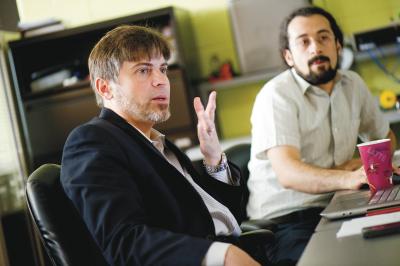Dec 10 2012
Imagine a human-like robot with skin and clothes embedded with sensors that could help machine accurately perceive the environment and better assist human owners.
 This is Dan Popa. Credit: UT Arlington
This is Dan Popa. Credit: UT Arlington
Such "smart" robots are at the heart of a new $1.35 million National Science Foundation project led by Dan Popa, a UT Arlington associate professor of electrical engineering. Popa is the principal investigator of a collaborative effort to advance robots and robotic devices, improve prosthetics and enable those devices to perform tasks that people can no longer do themselves.
"Our goal is to make robots and robotic technology more human-like and more human-friendly," said Popa, who leads UT Arlington's Next Gen Systems group within the College of Engineering. "Robotic devices need to be safe and better able to detect human intent.
"When someone is wearing a prosthetic, we want that prosthetic to be able to determine when a baseball is being thrown at it, then catch the ball."
The four-year project is part of the NSF's National Robotics Initiative, which is aimed at accelerating the development and use of robots in the United States that work beside or cooperatively with people. The UT Arlington team's grant was the largest among the initiative's 37 awards this fall.
Co-principal investigators are Zeynep Celik-Butler, professor of electrical engineering and director of UT Arlington's Nanotechnology Research and Education Center; Donald Butler, professor of nanotechnology and electrical engineering; Frank Lewis, professor of electrical engineering and the Moncrief-O'Donnell Endowed Chair; and Nicoleta Bugnariu, associate professor of physical therapy and neuroscience at the University of North Texas Health Science Center in Fort Worth.
Much of research will take place at the UT Arlington Research Institute in Fort Worth, which specializes in the advancement and commercialization of technology and advanced manufacturing.
The NSF says its robotics initiative can address a broad range of national needs such as advanced manufacturing, logistics, transportation, homeland security, defense, medicine, healthcare, space exploration and agriculture. NASA, the National Institutes of Health and the U.S. Department of Agriculture also are participating in the initiative.
Ron Elsenbaumer, UT Arlington provost and vice president for academic affairs, called the UT Arlington award a remarkable recognition of the advanced technologies being refined at the University.
"This important research represents an exciting opportunity for some of our leading electrical engineers and robotics experts to collaborate and optimize their technologies for the betterment of humankind," Elsenbaumer said.
Popa's project, "NRI-Small: Multi-modal sensor skin and garments for healthcare and home robots," predicts that "Co-robots of the future will share their living spaces with humans, and, like people, will wear sensor skins and clothing that must be interconnected, fitted, cleaned, repaired, and replaced."
Popa adds that the research will "unlock near-term and unforeseen applications of robotic skin with broad applicability, and especially to home assistance, medical rehabilitation and prosthetics."
Jean-Pierre Bardet, dean of the College of Engineering, called the collaboration one of the best examples of how UT Arlington researchers are developing real world solutions to improve people's lives.
"This is exactly the kind of team effort that will advance innovations developed in UT Arlington research labs toward the marketplace and help people live independently longer," Bardet said.
The work will capitalize on "smart skin" embedded with sensors developed by Celik-Butler and Don Butler, and algorithms and data networking developed by Lewis.